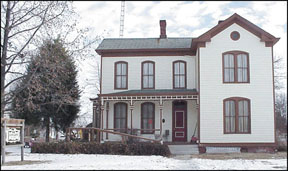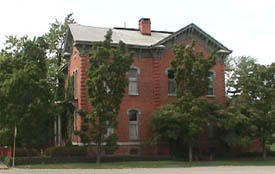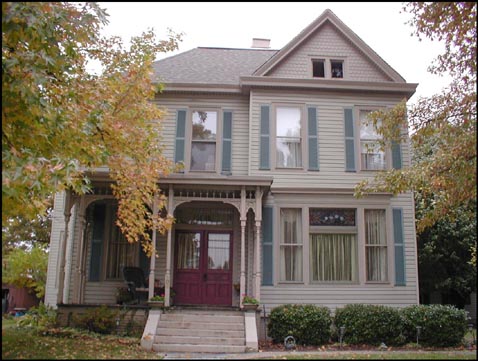White County
Historical
Society
Heritage House Articles
Right now this is a sample of the articles and photos of the homes.
We hope to add more as we find good articles and have the
time
to post them.

November 07, 2000
'Chestnut Grove' named 'Heritage
House'
By BARRY CLEVELAND Of The Times
Staff
A country home built before the
Civil War and beautifully
restored in recent years was
honored
Monday night with the White County Historical Society's
Heritage House Award.
The society presented the annual
award to "Chestnut Grove," a two-story frame home owned by Henry and
Jane Absher of Carmi and located in the heart of the
farm southwest of Carmi long known as "the Williams section." Illness
prevented the Abshers from
accepting the award in
person, but Rich Gurka, who lives
in the home, accepted on their behalf.
The presentation was made at the
end of a program that
included slides and a narrative
of the home's history and restoration by Kent F.P. Boeger,
a past president of the society.
The occasion was the annual fall
membership meeting of the
society, held at the VFW Hall
in Carmi, and a crowd of more
than 120 people attended.
It was the final general
membership
meeting at which Larry B.
Hughes of Carmi, the society's
president, would preside, as
those present unanimously elected
a new slate of officers headed by Jim Pumphrey, who will
take the group's reins Jan. 1. Lawrence Martin was elected vice
president, Sue Calvert secretary, Cindy Birk Conley
treasurer
and Sue Armstrong, Boeger, Marjorie Brown, Marjorie
Fechtig, Linda Minear, Rick
Stein, Lecta Hortin and Sam
Endicott
were elected directors. Hughes will serve on the board
as immediate past president.
Boeger's narrative included an
extensive discussion of the background of the "modest Greek
Revival" home. He noted that John Perryman, who then owned
the property where the house now sits, referred in his 1858
will to the house "now being built." The property was sold
in 1862 to
Samuel D. Ready, an Irish immigrant to Carmi (whose name
adorns the East Main Street building that now houses Pat's
Porch in Carmi and who erected an earlier building there that
bore his name). He acquired nearby parcels of land through
the early 1860s. The Ready family lived in Carmi but the
house was apparently occupied by a resident overseer named
Corcoran
(or Cochran). William St. John became the overseer in
1871. Sarah Jane, a daughter of Samuel
and Lucinda Ready, was married to Albert R. Shannon in
June 1845, and she inherited the real estate after her father
died in 1869. The property passed eventually to their
daughter,
Mary D. Shannon, who married James Robert Williams
in 1884. By 1888, she had acquired a total of 660 acres--the
entire section and an additional 20 acres nearby.
Throughout
this time the farm's overseers lived in the house,
which had been dubbed "Chestnut Grove."
The narrative noted that from its
earliest days the farm produced corn, oats, hay, winter
apples and chestnuts, and the record includes lists of fruit
trees planted in the 1870s and a detailed instruction to
the tenant farmer on how to prepare a mix used to "wash" each
tree twice annually. Boeger also quoted from a number
of family letters from the period which provided a flavor
of country life at the time.He noted, for instance, that
steamboats
regularly traversed the Little Wabash River, when
the water level was high enough, carrying freight from
White County down river. And he referred to an 1870 bill of $92
for clearing 23 acres of ground, and $51 for making and
putting up a rail fence of about 3,400 hundred rails. The owners
were, in the late 19th
century, among the county's most prominent people. James
Robert
Williams, the husband of Samuel Ready's granddaughter,
Mary D. Shannon, was a lawyer who served as a county judge from
1883 to 1887 and was elected to Congress, serving from
1889 to 1895 and again from 1899 to 1905. He was the
Democratic
nominee for U.S. Senate in 1903 and received the votes
of several delegates to the 1904 national party convention
for the vice presidential nomination. The couple is perhaps best
remembered
today for the imposing
mansion they built at the end
of the 19th century on the southeastern corner of Main and
Main Cross streets--a home which still stands and is known
by some as "The Castle."
Though they lived in town, the
couple remained attentive
toward the farm. Boeger quoted
from a 1903 order the Congressman made for 100
ornamental
trees from the U.S.Department of Agriculture.
The speaker interspersed his
narrative
with personal notes, recalling that his parents bought
a 40-acre farm adjacent to "the section" in 1929. He recalled
the long driveway leading from the township road to the
main house, a huge catalpa tree at its entrance and a very large
barn that stood nearby when he was a child. Known as "the
apple barn," it was built from timbers used in the construction
of the Russian exhibition building at the St. Louis World's
Fair of 1906, he said. The Congressman had the timbers
shipped
by rail to the Trumbull station, about 1.25 miles north,
where they were loaded onto wagons and pulled by mule teams
to the sight. There they were assembled. Boeger said the
driveway
through the barn was so large that two wagons could meet
and pass, and the main support posts (fashioned from
redwood and two feet square) were 30 feet apart. Originally
designed to store apples, by the '30s the barn was used to
store the farm's wheat and
corn, he said.
Boeger said Mary D. Shannon
Williams
died in 1934 and her son, Robert Ready Williams (born
in 1889) inherited the farm.By that time, he said, the
productivity
of the cropland had declined, and much of the farm
had grown up in species such as sassafras and persimmon. The
chestnut trees for which the house had been named had become
blighted and the apple orchards diseased, fields were
marked by gullies and the apple barn had become neglected. Robert R.
and Claire Williams
signed
an agreement with the White County Soil & Water
conservation District in 1946 to undertake conservation and
restoration
practices on the farm. Williams died two years later,
but his widow (who lived in the Carmi mansion) continued their
commitment. Fields were contoured, waterways and ponds
constructed, crop rotation
established and fertilizers
properly
used. Thickets were
cleared and between 1954 and 1967,
117,000 trees were planted, including red gum, bald
cypress and loblolly pine. Kenneth Stephens and his family
moved onto the section in 1952 and stayed until relocating
to their own home in 1976.
They were honored in 1969 by KMOX
Radio in St. Louis as the outstanding conservation family
in the southern half of Illinois. By this time 360 of
the farm's acres were given to raising corn, beans, wheat and
clover, and another 120 acres were forested. In 1976, Claire Williams
began
the process of restoring the old home; the original one-story
section in the back (built of logs) was completely replaced.
The lower portion of the porch was replaced, first floor
flooring replaced and a bathroom installed on the first
floor. Boeger noted that the flooring was of tulip poplar and
that all of the lumber used in the home's construction was
from the farm and had been milled on site.
Claire Williams subsequently died
and her son, Bob (who with his wife, Dodie, had relocated
to Carmi by that time) later the same year, suffered a heart
attack while at work on the farm. The property was sold in
1993 to the Abshers, and more restoration was begun. The second
story front porch was restored to its previous
appearance,
shutters added, front doors restored and a shake-style
roof was added. Landscaping was done, and Rich and Mary Jane
Hinchman Gurka moved in. The new tenants planted flower
gardens,
bricked patios and did substantial work inside the house,
said Boeger.
The speaker then took his
listeners
around and through the house with the benefit of colored
slides, taken by Jerry Wright, and he took note of the
antiques, family heirlooms and other furnishings throughout
the two-bedroom home.After Hughes presented the
Heritage
House plaque to Gurka, the longtime Department of Natural
Resources employee (conservation officer for White
and Gallatin counties) expressed his thanks to Dale
Peters,
who he said did most of
the most recent restoration. Gurka
also credited Debbie South and Niece Edwards with the
wallpapering,
Doug McFall with much of the interior work and
Marvin Allen with much of the painting. And he added that his
former wife (who now lives in Lake County) also deserves much
credit.
 The
Felix
Visknisski home was named a heritage house in 1974, when owned by the
Jackson
family. The home was built in 1876 for a Polish immigrant, who came to
Carmi in about 1868 and married a local girl, Carrie Clayton. Felix
operated
a general merchandise store, owned several farms, and was an early
shareholder
in White County Bank. The Viskniskki family owned the home until 1968,
when the Jacksons purchased it. They were followed in the 1970s by two
other short-term owners until James and Cindy Conley bought the
property
in 1981, when it became James' law office. The home was damaged by fire
in 1998 and was not fully restored until 2002, after the death of Mr.
Conley.
Mrs. Conley now lives in the structure and uses it as an accounting
office.
The
Felix
Visknisski home was named a heritage house in 1974, when owned by the
Jackson
family. The home was built in 1876 for a Polish immigrant, who came to
Carmi in about 1868 and married a local girl, Carrie Clayton. Felix
operated
a general merchandise store, owned several farms, and was an early
shareholder
in White County Bank. The Viskniskki family owned the home until 1968,
when the Jacksons purchased it. They were followed in the 1970s by two
other short-term owners until James and Cindy Conley bought the
property
in 1981, when it became James' law office. The home was damaged by fire
in 1998 and was not fully restored until 2002, after the death of Mr.
Conley.
Mrs. Conley now lives in the structure and uses it as an accounting
office.
 The Webb
Hay
house received the Heritage House award in 1995, while owned by Kent
Boeger,
long-time chairman of the Heritage House committee. The home was
certainly
a worthy choice, as it was built by the Webb and Hay families in 1876
but
had been used as a rooming house from at least the 1920s to the 1980s,
when Kent and his wife Timmye rescued the derelict property. It has a
sturdy
Italianate design and fantastic architectural trim around the windows
and
roof. Much of the work on the house was done by the Boegers themselves.
In 2000 the Boegers decided that health problems made the large home
too
much work for them and sold it to the Jim Minnick family, who lived in
the house until 2007. In 2008 it was purchased by Glenn and Mary
Coleman, who also own the nearby "Castle". His son and daughter-in-law
are living in the home at present.
The Webb
Hay
house received the Heritage House award in 1995, while owned by Kent
Boeger,
long-time chairman of the Heritage House committee. The home was
certainly
a worthy choice, as it was built by the Webb and Hay families in 1876
but
had been used as a rooming house from at least the 1920s to the 1980s,
when Kent and his wife Timmye rescued the derelict property. It has a
sturdy
Italianate design and fantastic architectural trim around the windows
and
roof. Much of the work on the house was done by the Boegers themselves.
In 2000 the Boegers decided that health problems made the large home
too
much work for them and sold it to the Jim Minnick family, who lived in
the house until 2007. In 2008 it was purchased by Glenn and Mary
Coleman, who also own the nearby "Castle". His son and daughter-in-law
are living in the home at present.
 The
Morris
Blasker house, under restoration by the Terry Gholson family, was named
a Heritage House in 2002. You can see the marvelous late Victorian
details.
I should have the complete article somewhere on my computer.
The
Morris
Blasker house, under restoration by the Terry Gholson family, was named
a Heritage House in 2002. You can see the marvelous late Victorian
details.
I should have the complete article somewhere on my computer.
Related Resources
Visit White County on the
USGenweb
project White County,
Illinois
Included are Charlene Shields' weekly genealogy columns from the CARMI
TIMES, queries, a short history, and look-up information. Here is the
page
for our neighbor to the south Gallatin
County, Illinois
Don't forget the Rootsweb home
page,
where you can find a wealth of information : Rootsweb
Home Page
Go back to the homepage.
Last updated 6/6/2010. Please
send
corrections and comments to cbconly@midwest.net
Your help will be appreciated.


 The
Felix
Visknisski home was named a heritage house in 1974, when owned by the
Jackson
family. The home was built in 1876 for a Polish immigrant, who came to
Carmi in about 1868 and married a local girl, Carrie Clayton. Felix
operated
a general merchandise store, owned several farms, and was an early
shareholder
in White County Bank. The Viskniskki family owned the home until 1968,
when the Jacksons purchased it. They were followed in the 1970s by two
other short-term owners until James and Cindy Conley bought the
property
in 1981, when it became James' law office. The home was damaged by fire
in 1998 and was not fully restored until 2002, after the death of Mr.
Conley.
Mrs. Conley now lives in the structure and uses it as an accounting
office.
The
Felix
Visknisski home was named a heritage house in 1974, when owned by the
Jackson
family. The home was built in 1876 for a Polish immigrant, who came to
Carmi in about 1868 and married a local girl, Carrie Clayton. Felix
operated
a general merchandise store, owned several farms, and was an early
shareholder
in White County Bank. The Viskniskki family owned the home until 1968,
when the Jacksons purchased it. They were followed in the 1970s by two
other short-term owners until James and Cindy Conley bought the
property
in 1981, when it became James' law office. The home was damaged by fire
in 1998 and was not fully restored until 2002, after the death of Mr.
Conley.
Mrs. Conley now lives in the structure and uses it as an accounting
office. The Webb
Hay
house received the Heritage House award in 1995, while owned by Kent
Boeger,
long-time chairman of the Heritage House committee. The home was
certainly
a worthy choice, as it was built by the Webb and Hay families in 1876
but
had been used as a rooming house from at least the 1920s to the 1980s,
when Kent and his wife Timmye rescued the derelict property. It has a
sturdy
Italianate design and fantastic architectural trim around the windows
and
roof. Much of the work on the house was done by the Boegers themselves.
In 2000 the Boegers decided that health problems made the large home
too
much work for them and sold it to the Jim Minnick family, who lived in
the house until 2007. In 2008 it was purchased by Glenn and Mary
Coleman, who also own the nearby "Castle". His son and daughter-in-law
are living in the home at present.
The Webb
Hay
house received the Heritage House award in 1995, while owned by Kent
Boeger,
long-time chairman of the Heritage House committee. The home was
certainly
a worthy choice, as it was built by the Webb and Hay families in 1876
but
had been used as a rooming house from at least the 1920s to the 1980s,
when Kent and his wife Timmye rescued the derelict property. It has a
sturdy
Italianate design and fantastic architectural trim around the windows
and
roof. Much of the work on the house was done by the Boegers themselves.
In 2000 the Boegers decided that health problems made the large home
too
much work for them and sold it to the Jim Minnick family, who lived in
the house until 2007. In 2008 it was purchased by Glenn and Mary
Coleman, who also own the nearby "Castle". His son and daughter-in-law
are living in the home at present. The
Morris
Blasker house, under restoration by the Terry Gholson family, was named
a Heritage House in 2002. You can see the marvelous late Victorian
details.
I should have the complete article somewhere on my computer.
The
Morris
Blasker house, under restoration by the Terry Gholson family, was named
a Heritage House in 2002. You can see the marvelous late Victorian
details.
I should have the complete article somewhere on my computer.